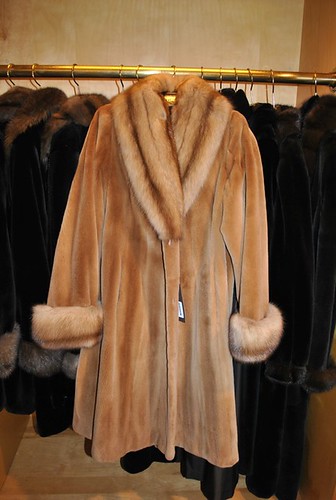 Columnist argues that humane animal treatment sets some fur sellers apart from others.
Columnist argues that humane animal treatment sets some fur sellers apart from others.
Fur better or fur worse, everyone has an opinion on fur.
Some would die to own a black-mink jacket, others would die to splash red paint on it. I’m not trying to persuade members of People for the Ethical Treatment of Animals to don a fox jacket or for Cruella de Vil to give up her fur vault. I wanted to learn more about the fur industry and form an educated opinion.
Originally, fur was one of America’s primary exports in the 16th century. Early Europeans traded their goods with Native Americans for pelts, which ultimately led to a vast fur-trade network between Native American tribes, colonists and British and French merchants.
As time passed, the demand for fur increased, which caused furriers to overhunt the most desired animals. Clothing manufacturers incorporated silk into clothing in lieu of fur because it was readily available, and the demand for fur declined.
As with any other type of fashion, the demand for fur is cyclical.

“The market has never been stronger for fur,” said Andre Ferber, proudly displaying one of the floor-length black mink coats from Jacques Ferber Furs at 17th and Walnut streets.
More than 75 designers incorporated fur into their 2011 fashion lines, among them BCBG, Diane Von Furstenberg, Donna Karan, Michael Kors, Oscar De La Renta, Ralph Lauren, Tommy Hilfiger and Vera Wang.
Fur trade has grown into a billion-dollar industry, but how does fur go from an animal’s back to a jacket on a human’s back?
According to Ferber, the animal is humanely euthanized, and the pelts are bathed in a combination of chemicals to preserve the fur’s integrity. After the preservation process, the pelts are cut into strips, and the strips are then used to make the garment.
Jackets are made by sewing strips from the pelts together. An animal may yield several strips depending on its size. For example, a stunning floor-length black mink coat required 60 strips, and each mink yields approximately one strip, ergo a single jacket requires approximately 60 minks.
However, not all fur requires a significant amount of animals. A fox jacket may require 15 foxes according to infurmation.com.
While there isn’t a perfectly humane way to deal fur, Jacques Ferber Furs stopped the sale of endangered species in the 1970s, and their most popular fur styles are American mink. According to the Fur Information Council of America, American fur standards for the treatment of fur farmed animals are significantly higher than those of the Chinese fur traders.
In October 2010, PETA produced a graphic video displaying the living conditions of animals involved in the Chinese fur trade. Because the Chinese government doesn’t enforce animal-protection laws, Chinese furriers are allowed to abuse the farmed animals without any repercussions.
Farmers will place their animals’ cages outside to roast in the sun during the day and freeze at night. They’re also exposed to the elements in cages barely large enough to allow movement. When the animal has grown to its ideal size, the Chinese furrier will skin the animal alive and dump the corpse into a landfill.
Because the Chinese fur industry is so gruesome, many fur dealers only sell humane fur. The seemingly guilt-free fur benefits the animal because they’re given a cage large enough to allow movement, an adequate food supply and tolerable living conditions. Fur merchants benefit from humane fur because it removes the guilt some consumers may have about wearing fur.
Personally, I don’t have a problem with fur as long as the animal is treated humanely and its remains are used for something, whether it be pet food, fertilizer or animal feed. If animals are already killed for domestic pet and animal feed, why does it matter if their fur is used for fashion, especially a fashion as intricate as fur?
While speaking with Ferber, there was a sense of pride when discussing the craft of assembling a fur jacket. Each coat is fabricated by hand, and it takes approximately a week’s worth of work to turn fur from a pelt into a coat.
When looking at and feeling a genuine fur jacket, the craftsmanship comes to life. It was fascinating that the fur and skin from the animal could be removed without damaging it or causing the hair to fallout. More importantly, the coats are incredibly warm, and some argue more environmentally friendly than the synthetic materials used in the production of faux fur.
As I mentioned earlier, I think people are entitled to their opinions regarding fur, and I respect both sides of the fur argument. While there are atrocious furriers like the Chinese farmers, there are also fur designers that are working to remove the negative stigma surrounding fur, and return the focus to the beauty of their craft.
Mark Longacre can be reached at mark.longacre@temple.edu.


Be the first to comment